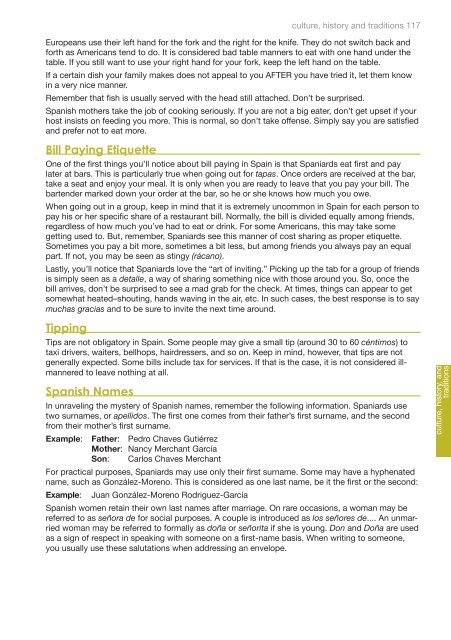teach in spain - UW Study Abroad
teach in spain - UW Study Abroad
teach in spain - UW Study Abroad
You also want an ePaper? Increase the reach of your titles
YUMPU automatically turns print PDFs into web optimized ePapers that Google loves.
culture, history and traditions 117<br />
Europeans use their left hand for the fork and the right for the knife. They do not switch back and<br />
forth as Americans tend to do. It is considered bad table manners to eat with one hand under the<br />
table. If you still want to use your right hand for your fork, keep the left hand on the table.<br />
If a certa<strong>in</strong> dish your family makes does not appeal to you AFTER you have tried it, let them know<br />
<strong>in</strong> a very nice manner.<br />
Remember that fish is usually served with the head still attached. Don’t be surprised.<br />
Spanish mothers take the job of cook<strong>in</strong>g seriously. If you are not a big eater, don’t get upset if your<br />
host <strong>in</strong>sists on feed<strong>in</strong>g you more. This is normal, so don’t take offense. Simply say you are satisfied<br />
and prefer not to eat more.<br />
Bill Pay<strong>in</strong>g Etiquette<br />
One of the first th<strong>in</strong>gs you’ll notice about bill pay<strong>in</strong>g <strong>in</strong> Spa<strong>in</strong> is that Spaniards eat first and pay<br />
later at bars. This is particularly true when go<strong>in</strong>g out for tapas. Once orders are received at the bar,<br />
take a seat and enjoy your meal. It is only when you are ready to leave that you pay your bill. The<br />
bartender marked down your order at the bar, so he or she knows how much you owe.<br />
When go<strong>in</strong>g out <strong>in</strong> a group, keep <strong>in</strong> m<strong>in</strong>d that it is extremely uncommon <strong>in</strong> Spa<strong>in</strong> for each person to<br />
pay his or her specific share of a restaurant bill. Normally, the bill is divided equally among friends,<br />
regardless of how much you’ve had to eat or dr<strong>in</strong>k. For some Americans, this may take some<br />
gett<strong>in</strong>g used to. But, remember, Spaniards see this manner of cost shar<strong>in</strong>g as proper etiquette.<br />
Sometimes you pay a bit more, sometimes a bit less, but among friends you always pay an equal<br />
part. If not, you may be seen as st<strong>in</strong>gy (rácano).<br />
Lastly, you’ll notice that Spaniards love the “art of <strong>in</strong>vit<strong>in</strong>g.” Pick<strong>in</strong>g up the tab for a group of friends<br />
is simply seen as a detalle, a way of shar<strong>in</strong>g someth<strong>in</strong>g nice with those around you. So, once the<br />
bill arrives, don’t be surprised to see a mad grab for the check. At times, th<strong>in</strong>gs can appear to get<br />
somewhat heated–shout<strong>in</strong>g, hands wav<strong>in</strong>g <strong>in</strong> the air, etc. In such cases, the best response is to say<br />
muchas gracias and to be sure to <strong>in</strong>vite the next time around.<br />
Tipp<strong>in</strong>g<br />
Tips are not obligatory <strong>in</strong> Spa<strong>in</strong>. Some people may give a small tip (around 30 to 60 céntimos) to<br />
taxi drivers, waiters, bellhops, hairdressers, and so on. Keep <strong>in</strong> m<strong>in</strong>d, however, that tips are not<br />
generally expected. Some bills <strong>in</strong>clude tax for services. If that is the case, it is not considered illmannered<br />
to leave noth<strong>in</strong>g at all.<br />
Spanish Names<br />
In unravel<strong>in</strong>g the mystery of Spanish names, remember the follow<strong>in</strong>g <strong>in</strong>formation. Spaniards use<br />
two surnames, or apellidos. The first one comes from their father’s first surname, and the second<br />
from their mother’s first surname.<br />
Example:<br />
Father: Pedro Chaves Gutiérrez<br />
Mother: Nancy Merchant García<br />
Son: Carlos Chaves Merchant<br />
For practical purposes, Spaniards may use only their first surname. Some may have a hyphenated<br />
name, such as González-Moreno. This is considered as one last name, be it the first or the second:<br />
Example:<br />
Juan González-Moreno Rodriguez-García<br />
Spanish women reta<strong>in</strong> their own last names after marriage. On rare occasions, a woman may be<br />
referred to as señora de for social purposes. A couple is <strong>in</strong>troduced as los señores de.... An unmarried<br />
woman may be referred to formally as doña or señorita if she is young. Don and Doña are used<br />
as a sign of respect <strong>in</strong> speak<strong>in</strong>g with someone on a first-name basis. When writ<strong>in</strong>g to someone,<br />
you usually use these salutations when address<strong>in</strong>g an envelope.<br />
culture, history, and<br />
traditions
















